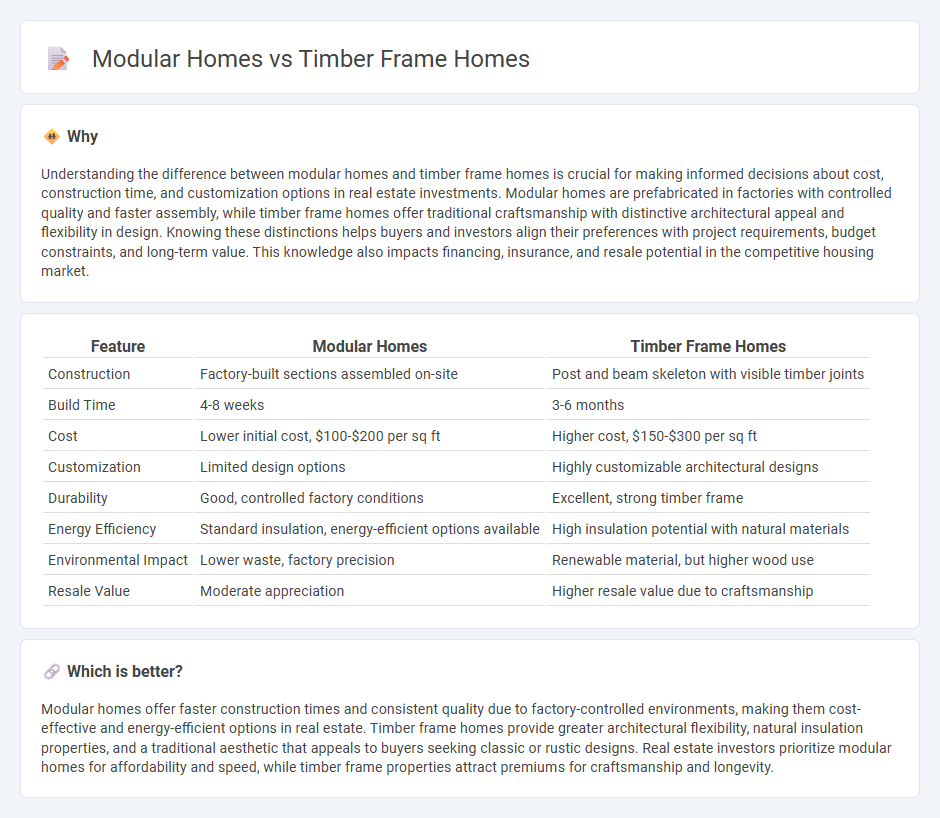
Modular homes offer rapid construction with factory-built precision, ensuring consistent quality and reduced waste compared to traditional building methods. Timber frame homes showcase exposed wood beams providing aesthetic appeal, structural strength, and sustainability through renewable materials. Explore the key benefits and differences between modular and timber frame homes to determine the best fit for your real estate investment.
Why it is important
Understanding the difference between modular homes and timber frame homes is crucial for making informed decisions about cost, construction time, and customization options in real estate investments. Modular homes are prefabricated in factories with controlled quality and faster assembly, while timber frame homes offer traditional craftsmanship with distinctive architectural appeal and flexibility in design. Knowing these distinctions helps buyers and investors align their preferences with project requirements, budget constraints, and long-term value. This knowledge also impacts financing, insurance, and resale potential in the competitive housing market.
Comparison Table
| Feature | Modular Homes | Timber Frame Homes |
|---|---|---|
| Construction | Factory-built sections assembled on-site | Post and beam skeleton with visible timber joints |
| Build Time | 4-8 weeks | 3-6 months |
| Cost | Lower initial cost, $100-$200 per sq ft | Higher cost, $150-$300 per sq ft |
| Customization | Limited design options | Highly customizable architectural designs |
| Durability | Good, controlled factory conditions | Excellent, strong timber frame |
| Energy Efficiency | Standard insulation, energy-efficient options available | High insulation potential with natural materials |
| Environmental Impact | Lower waste, factory precision | Renewable material, but higher wood use |
| Resale Value | Moderate appreciation | Higher resale value due to craftsmanship |
Which is better?
Modular homes offer faster construction times and consistent quality due to factory-controlled environments, making them cost-effective and energy-efficient options in real estate. Timber frame homes provide greater architectural flexibility, natural insulation properties, and a traditional aesthetic that appeals to buyers seeking classic or rustic designs. Real estate investors prioritize modular homes for affordability and speed, while timber frame properties attract premiums for craftsmanship and longevity.
Connection
Modular homes and timber frame homes share a connection through their reliance on prefabricated components, which enhances construction speed and quality control. Both building methods utilize engineered wood materials, with timber frame homes emphasizing exposed wooden frameworks while modular homes incorporate these elements within factory-built sections. This integration of timber framing in modular construction results in sustainable, energy-efficient housing solutions that reduce waste and onsite labor.
Key Terms
Construction Method
Timber frame homes utilize a post-and-beam construction technique, where large wooden beams are carefully joined with mortise and tenon joints, creating a sturdy skeleton that supports the entire structure, often leaving exposed wood interiors. Modular homes are built in factory-controlled sections or modules, which are then transported and assembled on-site, allowing for faster construction times and reduced on-site labor. Explore the detailed differences in construction methods for timber frame and modular homes to determine the best fit for your building project.
Customization
Timber frame homes offer unparalleled customization through exposed wooden beams and intricate joinery that can be tailored to specific architectural styles and personal preferences. Modular homes provide a flexible design framework with pre-fabricated sections that can be adjusted for layouts and finishes, enabling faster construction without sacrificing design individuality. Explore detailed comparisons to understand which option best aligns with your customization needs and lifestyle.
On-site Assembly
Timber frame homes feature an intricate on-site assembly process involving precise joining of heavy wooden beams, offering customization and a traditional aesthetic. Modular homes are constructed in factory-controlled environments, allowing for rapid on-site assembly with pre-fabricated sections, reducing build time and weather-related delays. Explore detailed comparisons to understand which construction method suits your needs best.
Source and External Links
Timber Frame Homes | PrecisionCraft - PrecisionCraft designs luxury timber frame homes that blend seamlessly into natural environments, featuring custom designs and traditional timber framing techniques.
Homestead Timber Frames - Homestead Timber Frames specializes in custom timber frame construction, offering bespoke designs tailored to individual needs across the United States.
Timber Frame Designs & Floor Plans - Timberbuilt offers award-winning timber frame home designs that incorporate structural insulated panels and load-bearing timbers for enhanced energy efficiency.
 dowidth.com
dowidth.com